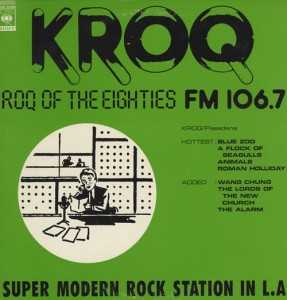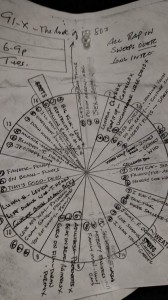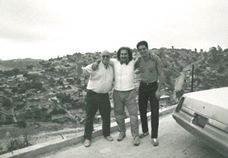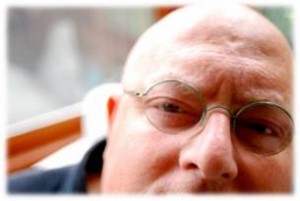It’s not always possible to determine the true origin of a radio format. Many start with multiple stations trying variations on a theme until the ether coalesces into something tangible. Others, like Sports Talk, (which we wrote about in a previous edition of Radio’s Most Innovative) have a crystal clear starting point. Alternative – the format formerly known as Modern Rock – falls into the latter category.
 The roots of the format can be traced back to one person: Rick Carroll who took over programming KROQ in 1979 and tapped into a new, underground movement that was taking over clubs in Los Angeles. He recognized that artists like the Cure, Depeche Mode, R.E.M. and U2 had a lot of fans but no home on FM radio.
The roots of the format can be traced back to one person: Rick Carroll who took over programming KROQ in 1979 and tapped into a new, underground movement that was taking over clubs in Los Angeles. He recognized that artists like the Cure, Depeche Mode, R.E.M. and U2 had a lot of fans but no home on FM radio.
The format would become known as “Rock of the 80’s” and take root primarily on the West Coast, followed by a few outlets in markets where stations start with the letter “W.” In the early ‘90s, the format spread across the country, fueled by the spread of Grunge music. Unfortunately, Carroll passed away in 1989 before getting the chance to see the widespread adoption of the Alternative seed he planted.
Carroll was truly an innovative thinker and a radio pioneer. To glean more insights about the format’s beginnings and Carroll’s contributions, we turned to one of the early disciples, Max Tolkoff, better known as “Mad Max,” PD and air personality of “Rock of the 80’s” first affiliate, 91X in San Diego.
JM: Talk about the influence of Rick Carroll, his vision for Modern Rock, and what it was like to work with him.
MT: When Rick took over KROQ at the tail end of the 70’s, he was simply looking for a way to differentiate the station from the rest of L.A. radio. On the rock side, KMET and KLOS were battling each other to the bottom of the ratings barrel, while CHR was limping along, not really setting the world on fire.
In an effort to find a USP – or Unique Selling Proposition – for KROQ, Rick started to target music that no one else was playing in L.A. Rick’s inner voice was saying, “Look at all these songs that COULD BE hits, but no one else is touching them.”
And to Rick it was all about the SONG. He wasn’t concerned about the career arc of bands (otherwise known as artist development). If they had a career, great; but if all we got out of them was one good song, that was fine, too.

Rick really saw KROQ as a prototype of a new version of CHR in L.A. He combined new music no one had heard before with the mechanics of Top 40. It was a crazy experiment that attracted a wacky staff of intense music heads who hoped the gambit would pay off, but were prepared for disaster. What happened next, of course, is the stuff of legend. Fame, fortune, ratings. And then consulting.
91X in San Diego was Rick’s first client as a consultant. He kept his job at KROQ, but started a consultancy called Carroll, Swartz, and Groves, believing that this new approach to radio had potential beyond L.A. Rick was a blast to work with, but he was more of a big picture guy. When it came to the nuts and bolts, he was a hot mess. Rick handled the day to day programming of 91X from L.A., and we used to get the “music wheels” sometimes minutes before the start of an airshift.
JM: What was the initial reaction to the idea of a station focused on this music that at the time, was mostly unheard of?
MT: In L.A., the response was positive, but not immediate. It took almost a year before KROQ was a household name among the core. In San Diego, the reaction was instantaneous and explosive. We changed formats almost three weeks into the 1983 Winter book and still jumped from a 3.9 to a 6.1. 91X went from the third rock station out of three to the talk of the town. A mere three tenths of a point separated us from the reigning king of rock, KGB.
JM: When the format rolled out in other markets, was the success as quick and powerful?
MT: Oddly, success was not immediate in San Francisco and Philadelphia, the two other markets where Rick signed consulting deals, but this was chalked up to less-than-stellar execution of the format.
JM: Were there indicators this music was becoming popular and that other programmers were missing its appeal?
MT: Absolutely. It was clear almost right away that bands like the Cure, Depeche Mode, and others had huge “underground” followings. These artists were selling large amounts of concert tickets and albums, not just overseas, but in the U.S. as well. All that was missing was airplay.
JM: What were the biggest obstacles the format had to overcome?
MT: The perception that it was all crazy punk or annoying dance music. That the only people that listened to KROQ or 91X, or Live 105, or WHFS, or WLIR had Mohawks or purple hair. Also, in the early years, sales departments had a hard time explaining the format to national advertisers.
JM: What were some of the early promotions and activities stations did that you just wouldn’t hear anywhere else?

MT: At 91X, we once gave away a six pack of Yugos. We also did a contest called “Expose the X,” where people were encouraged to send us visual evidence of their efforts to put the 91X logo in front of as many people as possible. Most of the other stations at the time also participated in on-air fundraising and radiothons around the “We Are The World” project.
JM: What role did local music have on the station?
MT: A huge role. It was acknowledged that many new bands were starting to happen in Southern California. Local music was not just appearing on weekend specialty shows, it took up key slots in regular rotation.
JM: What artists did the original Modern Rock stations play that might surprise people?
MT: Tom Petty, Michael Jackson, Madonna.
JM: It wasn’t just the music that was different. How were the jocks and the sound of the station different from what was on the radio at the time?
MT: Rick Carroll was very insistent that the on-air delivery be up and energetic. Not to the level of traditional CHR bombasticness, but close. All the jocks were encouraged to reimage themselves as entertaining on-air curators of the new sound. KROQ jocks had names like Freddie Snakeskin and Sam Freeze and Poorman. And the jocks were encouraged to use “drops” in between songs. There were also hourly “jock choice” picks for music.
JM: Was it a music format, a lifestyle format, or both?
MT: Both. If you were into this music, you also generally lived a somewhat different lifestyle. Although, it was soon discovered, fans of the new format came in all shapes and sizes and tastes. It wasn’t just college kids. It was kids in high school, as well as Gen X-ers just hitting the workforce and corporate types in shirts and ties.
JM: There had to be people who were critical of the idea. What did they say at the time?
MT: Many people thought these stations were just a novelty, a flash in the pan. Lots of people predicted that many, if not all, of those practicing the format would flip to something else within 18 months, or sooner.
Before 91X flipped to the format, the GM had commissioned two separate research projects to find a format hole for the station. Both concluded that the “new music” approach would never work in San Diego.
JM: With technology today, can you imagine another radio format growing out an underground movement like “Rock of the ‘80s” did?
MT: Yes. If you are awake and paying attention in this industry, you know that everything is cyclical. Format popularity goes up and down continuously. Generally, whoever is the source of great music wins.
 At the moment, it’s a little surprising that no one has taken a shot at a viable EDM radio format. Given the current popularity of DJs, raves, and incredible music sales, one would think this is a great “alternative” to everything else out there.
At the moment, it’s a little surprising that no one has taken a shot at a viable EDM radio format. Given the current popularity of DJs, raves, and incredible music sales, one would think this is a great “alternative” to everything else out there.
JM: What is your favorite memory of the early days of the format?
MT: In San Diego, there was so much excitement in the air after we switched formats in 1983. It was an incredible feeling going around town and hearing the station on in nearly every small store and restaurant. I didn’t need to monitor 91X in just my car. You could hear it everywhere. It was a broadcaster’s wet dream.
JM: What’s your best advice to someone with a new format idea?
MT: Condense your idea to a succinct two minute pitch. Then try to get to the decision maker. That person is likely to be the GM or market manager. They are the real gate keepers. They are the only ones who have the power of life and death over formats. If you can convince that person you have a ratings winner, followed by huge increases in revenue, you can get a new format on the air.
Thanks to Mike Stern for writing this week’s RMI.
INNOVATION QUOTE OF THE WEEK
Technology is huge; I wanted to learn about it. People might say that’s odd, but I think it’s odd if artists aren’t interested in the world around them. I’m always chasing that.
Bono
More of Radio’s Most Innovative
- Radio’s Most Innovative: Paul Lamere
- Radio’s Most Innovative: Greater Public’s Doug Eichten
- Radio’s Most Innovative: George Gimarc
- Radio’s Most Innovative: WNIC’s “Pillow Talk” with Alan Almond
- Radio’s Most Innovative: Austin City Limits Radio
- Media And Technology In 2025: Believe It Or Not! - April 18, 2025
- In Radio, You Just Never Know - April 17, 2025
- The Secret To Making A Great Podcast (And Great Radio) - April 16, 2025





I’ve kind of wondered myself why there haven’t been more attempts at doing an EDM format–although I wouldn’t go so far as to say that “no one has taken a shot” at doing so, even just within the U.S. This includes not just iHeart’s “Evolution”, but also a handful of other stations, some HD subchannels, and even WDET’s “Alpha” programming.
Still, the EDM industry (and, yes, it’s truly an industry now) has been able to grow and grow without a lot of direct support from radio; you may even be able to make a case that EDM is really a “post-radio” music genre. That said, it could also be that the best examples of stations with EDM-heavy Dance formats are outside of the U.S.–including maybe Mexico City’s “Beat 100.9” (XHSON) and New Zealand’s “George FM”, whose owner (MediaWorks) recently announced a national expansion.
Ironically, Michaelangelo Matos’ “The Underground Is Massive: How Electronic Dance Music Conquered America” was recently published. It’s possible that there may be some related analysis in that book.
Eric, radio has rarely been first with new formats. I can attest to that. When I launched the Classic Rock format in ’83 (and didn’t sign my first FM station on until ’85), I’m convinced the format would have been viable at least two years earlier. Stations like KNDD in Seattle are dabbling in EDM shows during select hours. You would think with all those lame HD2 stations just laying there, broadcasters would be more willing to take a shot with a format in a playground that is truly experimental. A secondary stream wouldn’t be a bad idea either. Thanks for the reminder and for reading our blog.
Rick’s legacy lives on at the HD2 of KROQ, which is “Roq of the 80s” and programmed by Freddy Snakeskin these days.
And, of course, Rick’s pioneering work was very useful in the initial research for my own “Eighties Channel” format.
I met Rick once, pre-KROQ, when he was PD of KKDJ, the first FM CHR in Los Angeles to be even moderately successful; I was just starting out in the business but he still took several minutes out of his day to talk with me about what he was looking for in air talent. He left us much too soon.
Thanks for sharing those memories and for reading our blog.
This is yet another proof that if you want to know what music you should play in a radio, you should first go out and see what people listen in the pubs.
There is a famous history from Ohama (Nebraska). T. Storz and B. Stewart from the radio station KOWH-AM were drinking alcohol in a pub. They were distressed by poor outcomes . They were in a bar with plenty of jukeboxes. They’ve noticed that customers were selecting the same songs from usually the same genre whole day. They also observed that despite the fact that bars had dozens of jukeboxes with several thousand songs, people were selecting the same songs and what’s more, in a similar order. When they asked why – the waitress said: “Because we like these songs!”
It all reminded me about one part from your article: Live & Global
“Anil told the room that in India, they do” people research, “not” music research. “He talked about how his stations send staffers around town is observe people in Their everyday lives, going to work, taking the bus, shopping on the streets, and just hanging out. ”
Two examples of polish artist that don’t have “home on FM radio” in Poland.
https://www.youtube.com/watch?v=NAeJFU_pK0M – Peter J. Birch
https://www.youtube.com/watch?v=eo8J3gW8N2E – Agatha
There is no question, Pawel, that observing and listening to people can be great “research.” And when you start to detect a trend from watching people dance at a wedding or conducting listener advisory board groups in your station conference room, you can then test your assumptions quantitatively. Or as Storz did, put it on the radio and see what happens. Thanks for the comment and reading our blog.
I met Rick Carroll in 1965 in Redding, California where he was just starting out in radio after graduating from college. Great guy who managed my rock n’ roll band such as it was and took me along to concerts he was emceeing in the area. First one was at Chico State starring The Shangri-Las. We had a blast in those days. I knew him for much of the rest of his life as we both lived in LA and saw one another from time to time.
Vincent, thanks for those memories of a true innovator.
I know this is a few years late but was just sent a link to this. I wanted to say this radio format was HUGELY influential in my life-long music taste and it started at a station Rick Carroll had once interned at- KPOP 93.5 in Roseville/Sacramento CA. The very sad thing was that it only lasted five months there, from August 1st, 1983 (they had teased it a few weeks prior, saying that “something big” was coming on that day) and killed off in January 1984 in favor of top 40 which many other stations were already doing. I’d been a top 40 listener before discovering this format but with it suddenly gone, I knew I could never go back. Thankfully I could still get The Quake out of San Francisco, which was mentioned here as “less-than-stellar execution” but I certainly loved it. They at least had the decency to warn listeners a few weeks in advance of a sale and format change in 1985, but it was still devastating having no place left to go after that. Live 105 came around in 1986 and certainly was more successful, but their signal was far worse and I could rarely pick it up.
Sadly I think the format nowadays isn’t nearly what it was in the 80s. There used to be peaceful co-existence of both dance and synth-based pop along with harder guitar-driven stuff, but when Nirvana and grunge got big all the pop stuff was kicked to the side. Besides that, the songs that were big in the 90s were played FAR too often when they were new and STILL get played too much today when new music should be played instead. Admittedly, had the format shifted to exclusively techno and EDM, I would’ve liked that a lot more and likely wouldn’t complain so much. But despite this format being “magic” in 1983, that’s just gone from radio today and I hardly pay attention to it anymore.